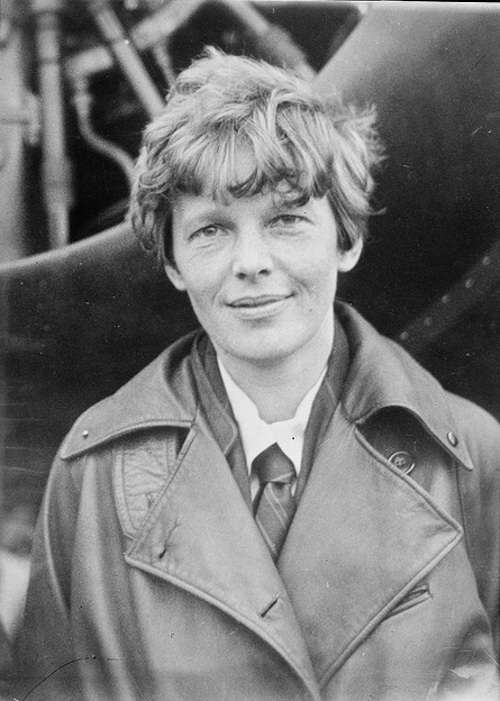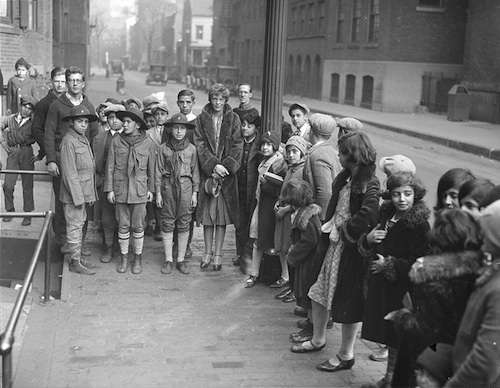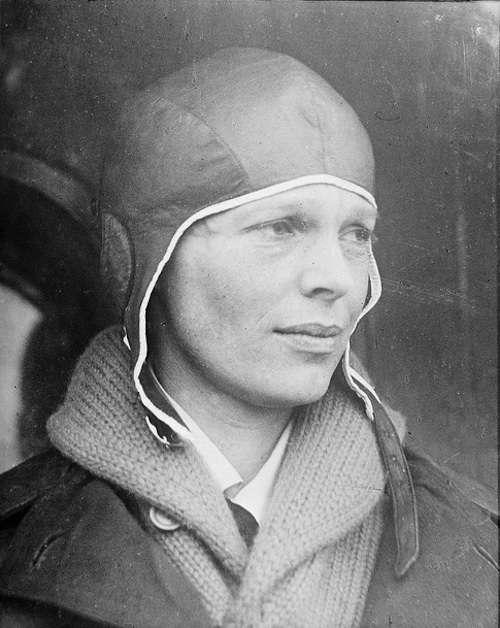Amelia Earhart (1897-1937): Social Worker, Women’s Advocate, World Famous American Aviation Pioneer
By Dr. Julie Miller-Cribbs and Julianne N. Mains, University of Oklahoma Tulsa Campus

Photo: Boston Public Library, Leslie Jones Collection.
Introduction: In the early 1900s, increasingly more women were obtaining their college degrees. Despite this increase, career choices for these newly educated women were quite limited. Most of these women were not accepted into the professional positions typically dominated by men. Therefore, many women, including Amelia Earhart, first chose careers in service, such as social work, teaching, and nursing.
Amelia Earhart was born on July 24, 1897, in Atchison, Kansas. She was the firstborn, with a sister—Muriel—born three years after her. Amelia’s family moved around quite a few times as Amelia grew up, including moving six times during her four years in high school. As she finished high school, Amelia’s parents chose to get a divorce. Upon graduating, she decided to leave her family and attend college at The Ognotz School in Philadelphia, Pennsylvania, becoming a part of the second generation of women to attend college. One semester before finishing her degree, Amelia left college to be a nurse’s aid during World War I. This began her desire to help people, which eventually led her to a career in social work.

Photo: Boston Public Library, Leslie Jones Collection.
Amelia Earhart Working at Denison House: Many people are unaware that Amelia Earhart was a social worker before she made her claim as one of the most well known female pilots in history. After working as a nurse’s aid during World War I, Earhart spent the next few years of her life in service to others. Without any previous social work experience, she was hired in 1925 as a social worker at Denison House in Boston, the second oldest settlement house in the nation. Three women—Vida Scudder, Katherine Coman, and Emily Balch—founded Denison House in 1892. Settlement houses offered a new career option for women—social work. Like many ambitious, motivated and educated women of her time, Earhart found herself immersed in the social work field.
At the time Earhart began working at Denison House, settlement houses were designed to serve immigrants and the urban poor. Yet they were also places of exciting social change, new thinking, and they provided new paths for girls and women. Earhart caught this vision and quickly became immersed in her job. She was in charge of adult education soon after coming on staff, and soon also organized other clubs for the women of the neighborhoods, such as the Syrian Mother’s Club. She enjoyed working with children and was the supervisor of the girls’ program. In this respect, she delved into another realm she enjoyed (and was actively discouraged from participation as a girl)—sports. Amelia taught the immigrant young girls how to play basketball, as well as how to fence. As she was entrusted with more programs, her influence spread outside of Denison House. She became the Denison House delegate for the Conference of the National Federations of Settlements, which took place in Boston. Even there, she was in the spotlight as one of the most promising social workers of her generation.

Photo: Boston Public Library, Leslie Jones Collection.
Amelia Earhart as a Pilot Several times, Amelia’s two passions—social work and flying—united. During a benefit for Denison House, she took an
airplane and flew over the benefit, which made headlines. She also had the notion to set up a womens flying organization and help more women become aviators. Many say Amelia would have stayed in social work, had a call not come inviting her to try a new adventure in aviation and volumes have been written documenting her career as one of the most famous female aviators of all time.
Even though she only remained at Denison House three years, she made a lasting impact on the children and families she served, the other staff members, social workers, and on social work as a profession. Her work with immigrants and the activities she established and facilitated carried on even in her absence. Remarkably, although brief, little is known about Earhart’s contribution to the field of social work despite her well documented life and her landmark achievements in aviation.
Settlement houses, obviously well known for their impressive work with poor and oppressed groups, often provided avenues for work for some of history’s remarkable women and Earhart was one of these. It is likely that this forward thinking, women-friendly environment provided the opportunities that women such as Earhart embraced.
How to Cite this Article (APA Format): Miller-Cribbs, J. & Mains, J. (2011). Amelia Earhart (1897-1937): Social worker, women’s advocate, world famous American aviation pioneer. Social Welfare History Project. Retrieved [date accessed] from https://socialwelfare.library.vcu.edu/people/earhart-amelia/
20 Replies to “Earhart, Amelia”
Comments for this site have been disabled. Please use our contact form for any research questions.

Does the Denison House building on Tyler Street still exist?
Yes. The original site at 93 Tyler Street is a stop on the Boston Women’s Heritage Trail. You can read more here.
My mother Isabel Tawa, was the daughter of Syrian immigrants.She spent most of her free time at the Denison House, as a child.She always spoke fondly of her “teacher,”Amelia Earhart. My mother so enjoyed spending time with Amelia,who brought such excitement to the children she mentored.Amelia would bring out the inate creativity in which their eager young minds just flourished.She taught many things… and left a lasting impression on a little Syrian girl,growing up in the South End of Boston. Also,my grandfather,George Tawa invented the “sugar cone”,which has absolutely nothing to do with Amelia Earhart,but I just thought I’d add that little caveat..
Thank you Amelia Earhart,for bringing such joy to many…
I read that the poet Kahlil Gibran, and his relative, the sculptor Kahlil Gibran, took classes at Denison House as children. I bet there are lots of other notable people who did, but I can’t find any information about them. So much has been written about Denison House, but all of it seems to be from the point of view of the staff, and centered around their experiences. Have members of the community written anything about it?
Dear Rose Mary: You are correct that there are many famous and interesting historical figures who were influenced or helped by staff and activities of settlement houses and neighborhood houses. Unfortunately, for the Social Welfare History Project our primary sources of information about settlements and others is what is available and eligible to copy. However, if you have the time and energy it is possible to locate other sources of information about settlements and related social agencies, including notable persons they have helped in one way or another, particularly if you are not planning to copy and publicize the information you find. Google is a tremendous resource for locating these historical files. Best wishes, JEH
Google, really? That’s like telling me to go —- myself. I don’t think I deserve that.
I’m not looking to “out” anyone, not that having visited a settlement house is anything to be ashamed of. I’m just surprised so little seems to have been written about them from a non-staff point of view. In Gibran’s case, his wife mentioned Denison House in her memoir. Also, this being a “Comment” section, I was commenting, as though to one or more human beings with an interest in the subject, not filing a subpoena.
[…] You see my references and read more about Amelia Earhart here and here. […]
My grandfather was a student at Denison house during Amelia’s time there.
My mother Helen Shaheen was a student of Amelia at the Denison House she is of Syrian decent and has a photographer of Amelia and several of her younger friends and fellow students all about Amelia’s big convertible.
Hi Walter, if you have any stories you’d like to share, we’d love to hear them! Thanks for commenting.
[…] She tried college again, then became a teacher, then in 1925 she got a job as a social worker at Denison House in Boston. It was the second oldest settlement house in the nation. Social work then offered a a […]
My grandmother worked at the Denison house with Amelia. They were going friends and during the Holiday she would fly my grandmother home to be with her family.
Thank you for the comment. Jack Hansan
Sorry, I don’t have any more at this time. Jack Hansan
I have no other suggestions. Jack Hansan
I am sorry the suggestion did not help. I don’t have any others. Jack Hansan
Thanks for your comment. Jack Hansan
Thank you for the comment. Jack Hansan
Hi so I’m doing my junior research paper on Amelia earharts influence on women of the 19th century and how it ripples into todays society, I was wondering if you had any suggestions.
My suggestion is to Google: “Women’s History.” There are several good sites with biographical information on Amelia Earhart. Regards, Jack Hansan